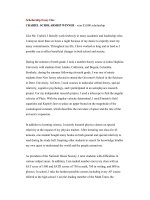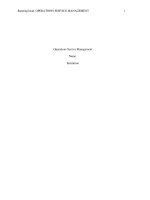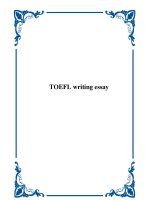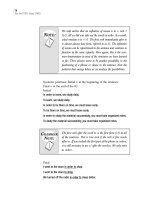arumentative essay
Bạn đang xem bản rút gọn của tài liệu. Xem và tải ngay bản đầy đủ của tài liệu tại đây (49.12 KB, 2 trang )
WEEK 8 – LE PHUONG THAO
THE ARGUMENTATIVE ESSAYS
I.
Definition:
The argumentative essay is used to convince or persuade someone to change
their preference, belief or faith, and fact (for research). It attempts to change the readers'
mind and to convince the readers to agree with the point of view or opinion of the writer.
Therefore, the arguments in this kind of essay should be established effectively and
logically.
II.
Organization:
1. planning:
-
The writer must stand one side of the issue -> your arguments become
stronger, and more convincible.
-
Be aware of the readers -> assume that they disagree with you -> try to
convince them respectfully, logically and objectively.
-
Predict the opposing arguments so that you have a plan to refute (to prove
wrong by argument or to show that something is erroneous) effectively.
-
If the opponent has a valid point, concede that point then try to prove that
yours is more important anyway.
-
The essay should offer reasons and support for those reasons.
2. organizations:
Pattern 1:
1. Introduction: Thesis statement
2. Body:
PRO idea 1: showing arguments and/or reasons to support your
opinion
PRO idea 2: showing arguments and/or reasons to support your
opinion
CON(s) (counter/oppose arguments) ----->Your Refutation(s)
3. Conclusion
Pattern 2:
1. Introduction : Thesis statement
2. Body:
CON(s) (counter/oppose arguments) -----> Your Refutation(s)
PRO idea 1: showing arguments and/or reasons to support your
opinion
PRO idea 2: showing arguments and/or reasons to support your
opinion
3. Conclusion
Pattern 3:
1. Introduction : Thesis statement
2. Body:
CON idea 1 (counter/oppose argument)
CON idea 2 (counter/oppose argument)
CON idea 3 (counter/oppose argument)
-----> Your Refutation
-----> Your Refutation
-----> Your Refutation
3. Conclusion
Pattern 4:
1. Introduction : Thesis
2. Body:
PRO idea
opinion
PRO idea
opinion
PRO idea
opinion
4.
Conclusion
statement
1: showing arguments and/or reasons to support your
2 : showing arguments and/or reasons to support your
3: showing arguments and/or reasons to support your
3. types of argumentative compositions:
* Showing the advantages and/or disavantages
* Giving opinions
* Giving solutions to a problem
* Showing arguments - for or against a topic
III.
How to make your arguments effective?
First of all, you have to understand what point to be argued. In the other word, you
have to understand the " heart" of the issue. All formal arguments are based on logic.
There are 2 kinds of formal logical reasoning: inductive and deductive.
Induction refers to the process of examining particular details and arriving at a
conclusion based on that evidence.
Deduction refers to the process of arriving at a conclusion about a case based on
a generation. In deduction, you start with a generalization and apply it to a special case,
then come to a logical conclusion. This process is also called syllogism. The
generalization is called major premise, the specific case the minor premise, and the
resultant statement the conclusion.
Example:
Major premise: Only inexpensive sources of energy should be developed.
Minor premise: Nuclear power plants are not cheap source of energy.
Conclusion: Nuclear power plants should not be constructed.
Exercise: Logical or illogical?
1. The sun is bright. Mary is bright. Mary is the sun.
2. All football players are strong. Bill is strong. Bill is a football player.
3. All mammals are warmblooded. Cats are mammals. Cats are
warmblooded.









